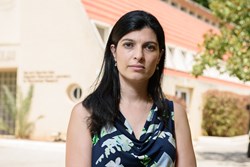
The deceptively simple, three-dimensional beauty of origami starts with a single sheet of paper, which must be precisely folded to become a swan or frog or crane. Similarly, the proteins that carry out many of the tasks in cells also must be accurately folded into three-dimensional structures; in their case, in order to perform their specific function and keep the organism – for example, you – in good shape. When origami is misfolded, the result is a pile of crumpled, formless paper. But when proteins don’t fold properly, the result is not so benign. In fact, it can be devastating: the misfolded proteins can clump together into aggregates that are toxic to normal, healthy cells. Dr. Rina Rosenzweig
Dr. Rina Rosenzweig
“Even a little bit of this aggregation causes disasters in our bodies,” says Dr. Rina Rosenzweig of the Weizmann Institute of Science’s Department of Structural Biology. “And protein aggregates are really a determining feature of many neurodegenerative and misfolding diseases,” including amyotrophic lateral sclerosis (ALS, or Lou Gehrig’s disease) and Alzheimer’s, Parkinson’s, Huntington’s, and Creutzfeldt-Jakob diseases. For example, the amyloid plaques associated with Alzheimer’s are actually clumps of misfolded proteins that damage brain cells.
“There’s currently no treatment for any of these diseases,” Dr. Rosenzweig states – a situation she hopes further research may one day change. Using a high-tech technique, nuclear magnetic resonance (NMR) spectroscopy, she is investigating the molecular mechanisms involved in reversing protein misfolding and the accumulation of toxic protein aggregates. NMR allows Dr. Rosenzweig and her team to study the structure and motions of large, flexible protein complexes.
As in origami, proteins must be precisely folded – this lets them perform their function and keep us healthy. However, when proteins aren’t folded properly, the results can be toxic.
“In my lab, we want to understand the machinery inside cells that can break apart protein aggregates and restore the proteins to a functional form,” she says. “I believe that such an understanding could lead to the development of therapeutic approaches to prevent, slow, or even reverse the progression of some of the most devastating diseases of our time.”
Every cell in every organism – from fungus to us – contains proteins that can misfold and unleash damage. Different organisms use different tools, or machinery, for breaking apart protein aggregates (a process known as protein disaggregation). In order to study these tools and put them to work to fight disease, it helps to have a research subject that is particularly good at breaking up protein clusters, and scientists found one with a very efficient disaggregation system: Baker’s yeast. It turns out that the simple Baker’s yeast has a powerful tool – a protein called Hsp104, which is also found in plants, bacteria, and fungi – that it uses to take apart these aggregates.
While a postdoctoral fellow at the University of Toronto, Dr. Rosenzweig used NMR to reveal the inner workings of Hsp104’s breakdown and refolding process. A strong believer in the power of collaboration, she worked with other research groups to find that Hsp104 itself collaborates with two other proteins, which activate it and bring it close to the protein aggregates in a cell. Hsp104 then pulls the clumped proteins apart, one by one, thus freeing them to refold correctly and perform their normal functions to keep the cell healthy. Or, as Dr. Rosenzweig more clearly puts it, “in other words, what I'm studying is the system that can un-fry an egg.”
Toxic clusters of misfolded proteins in the brain contribute to neurodegenerative diseases such as Alzheimer’s, Parkinson’s, and Huntington’s.
In her Weizmann Institute lab, Dr. Rosenzweig is now investigating the recently discovered protein disaggregation machinery in human cells. “We know very little about which proteins are involved in this system and how they come together to dissolve toxic protein aggregates,” she says. “But we do know it’s a complex system with very large and dynamic proteins.”
Understanding how cells are able to actually reverse protein aggregation – which is like a failed origami project turning itself back into a clean sheet of paper, then refolding into a perfect swan – could someday lead to powerful new treatments for the neurodegenerative disorders caused by clumps of misfolded proteins.
Born in Riga, Latvia, Dr. Rosenzweig came to Israel as a child, growing up in Haifa. After serving in the Israel Defense Forces (IDF), she enrolled at the Technion – Israel Institute of Technology in Haifa, where she earned her BA in chemistry and her PhD in biochemistry. It was while studying cellular proteins for her doctorate that she became enthralled with NMR: a collaboration with a University of Maryland scientist, using one of the world’s most powerful NMR systems at the Centre for Nuclear Magnetic Resonance Imaging in Lyon, France, opened her eyes to new possibilities, leading her to make NMR the focus of her postdoctoral research in Toronto.
Dr. Rosenzweig’s work “could lead to the development of therapeutic approaches to prevent, slow, or even reverse the progression of some of the most devastating diseases of our time.”
Dr. Rosenzweig was able to pursue that postdoc thanks to the Weizmann Institute’s Israel National Postdoctoral Award Program for Advancing Women in Science. The award was created by the Institute to enable more women to establish careers in science, for which postdoc work – typically overseas at the world’s most prestigious universities and labs – is considered essential. The funds help recipients – and, often, their families – move abroad, providing financial support for living expenses.
“The award really provides a huge vote of confidence and a much-needed support system for women who are pursuing an academic career,” says Dr. Rosenzweig, whose husband and two young sons moved with her to Toronto. The family returned to Israel when Dr. Rosenzweig joined the Weizmann Institute as a senior scientist in 2016.
“The Weizmann Institute is the ideal place to conduct my research,” says Dr. Rosenzweig. Soon this will be even more true, as the Institute is acquiring an additional, even more formidable NMR system, which will position it as one of the world’s premier centers for NMR research.
“In addition to housing the powerful new NMR magnet, the Institute has the people, the infrastructure, and the support you need for cutting-edge investigations” – investigations that could one day offer new hope for treating devastating diseases.
Dr. Rina Rosenzweig’s research is supported by the Benoziyo Fund for the Advancement of Science; the Blythe Brenden-Mann New Scientist Fund; the Azrieli Foundation; and the Estate of David Turner.
